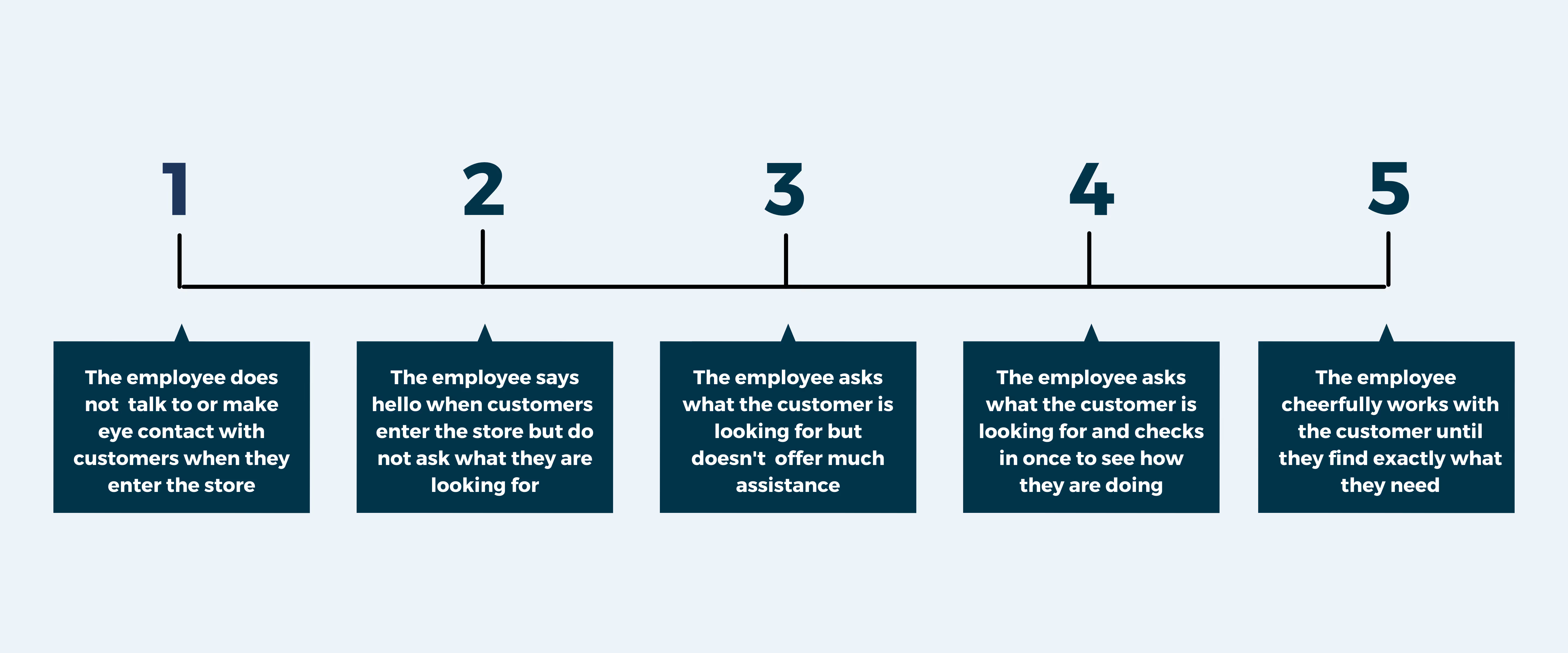What are Behaviorally Anchored Rating Scales (BARS)?
A Behaviorally Anchored Rating Scale, also known as BARS, is a performance management scale using behavior “statements” as a reference point instead of generic descriptors found on traditional rating scales.
Even in 2024, the BARS approach to performance appraisals is still widely adopted. The process is designed to add the benefits of both qualitative and quantitative information to the appraisal process; the BARS method measures an employee’s performance against specific behavior examples that are given a rating for data collection.

Establishing specific behaviors for grading gives the rating a higher degree of accuracy relative to performance. This is because you’re relying on unique behaviors required for each position within an organization instead of behaviors evaluated across the board.
It’s presumed that using a rating scale with specific behaviors for selected jobs minimizes the subjectivity in using basic ratings scales.
For now, let's dive into some examples of what BARS might look like.
Examples of Behaviorally Anchored Rating Scales
The job being appraised belongs to a customer service representative:
- A level four rating might assume the rep answers the phone after 1 to 2 rings with a friendly greeting
- A level six rating might assume the rep answers phone after 1 ring with the correct company greeting
A traditional rating scale would ask if the employee answers phone promptly/courteously and list the number ratings:
- 1: Never
- 2: Not Often
- 3: Sometimes
- 4: Usually
- 5: Always
There will be a difference in the outcome of the appraisal with the more definitive BARS method.
The job being appraised belongs to a nurse:
- A level four rating might assume the nurse shows sympathy to patients
- A level six rating might assume the nurse shows higher levels of empathy in all dealings with the patient and their family
The job being appraised belongs to a waiter:
- A level 2 rating might assume the waiter talks on phone while taking orders
- A level 4 rating might assume the waiter makes eye contact with customers during every transaction
- A level 6 rating might assume the waiter greets customers cheerfully and makes suggestions from the menu based on their preferences
What Are the Pros and Cons of the BARS Method?
While these examples are a great insight into the effectiveness of the BARS method, not everything about Behaviorally Anchored Rating Scales is perfect. There are several benefits to making the switch, but also downsides too.
Benefits of Using the Bars Approach:
- It's easy to use. The standards upon which the employee is being appraised are significantly clear which makes the entire process much less confusing.
- It's based on behavior. The goal of employee appraisals is to improve performance. Having a better understanding of the behaviors and what leads to them, allows the company an added perspective to what works and what doesn’t.
- It's impartial. BARS is focused on behavior, the evaluation process seemingly has more fairness.
- It is completely individualized. BARS designs a unique performance management experience for every position within an organization.
Downsides of Using the Bars Approach:
- It’s a time-consuming process. As great as it sounds to design the unique experience for each position, an organization with many different roles would have to invest an enormous amount of time and resources to get it done.
- It can be expensive. Time is money. That's why it's important for small businesses to use performance management platforms with multiple roles, this may not be feasible in the short run.
- It demands a management team that is highly devoted/motivated. All the statements and anchors used on the appraisal need to be developed. It is demanding and managers would have to be highly involved.
- It can be accused of leniency bias. BARS directly removes the opportunity for an evaluation to be biased, however, it doesn’t remove them all. Some believe there is still room for the leniency error.
Alternatives to BARS
Different camps within the social science community are the most effective when looking beyond what BARS can when used as part of employee engagement software to enhance performance and culture. There are alternatives to the BARS method out there, and each has its pros and cons:
Five-level graphic rating scale
This is the most common performance management software scale. This method uses descriptive labels like 'excellent,' 'good,' or 'average.' This method is simple to understand, but because it's so black and white, it's prone to subjective bias.
The two-point rating scale
A long while back, there was a blip on the radar of businesses when an engineering firm briefly used this method to rank within a two-point decimal rating scale from 0.01 to 10.00.
Stacked ranking
This breaks down employees into three categories- A, B, and C – with the A class viewed as the most profitable, while anyone who ranked in the C class was typically let go. This method took care of top performers but caused destructive competition.
Some of these scales rely on nominal, ordinal, and binary data types. These three data types are the most collected, and here's what they stand for:
- Nominal = Categories - The answer options have no relationship to each other; you're asking a question that generates nominal data. These are typically found on review forms.
- Binary = Yes or No
- Ordinal = Ordered List - Ordinal data is collected by asking rating scale questions which then feed into a scale, where questions are based on the question's validity and how the person feels about the data collected on the scale.
Likert Scales
Likert scales are symmetrical, with an equal number of positive and negative responses. They're also balanced with the distance between choices. Likert scales measure statement response, with the most common example being: Strongly Disagree - Disagree - Neither Agree nor Disagree - Agree - Strongly Agree.
Likert's typically have five choices but are almost always an odd number, so there can't be a neutral choice. An even number of options is called a "forced choice" and doesn't give a neutral option, so the respondent must pick a side.
Semantic Scales
Semantic scales are like Likert scales but with two extremes.
The averages are more significant because you're asking to rate the success of a project with seven possible options.
Custom Scales
Custom scales allow HR teams to create rankings that fit their specific needs. The risk of custom scales is that they lead to unexpected data distortions in data. If a custom scale is adopted, checks and balances must be implemented so the data is honest.
Who Is the BARS Approach Best For?
After taking a closer look at the pros and cons of using Behaviorally Anchored Rating Scales, one can expect that the method is best used by larger companies financially capable of pursuing the project.
Realizing that major manager input is mandatory, the company also needs to have understandable time and commitment expectations.
It would be ideal if the company didn’t have many different positions but rather, groups of positions or departments made up of similar types of jobs. Being that this approach is still a measuring system used for rating employees, another suitable use for BARS is when you encounter bias challenges in the current performance management process. Its emphasis on behavior produces objective ratings difficult to distort.
How to Set Yourself up for Success
If you want to include BARS in your performance management plan, it’s recommended that you start by diligently researching the approach. Be prepared with a full understanding so that you can execute the method properly for your own organization.
We also recommend using performance management software. Performance management software makes it easy for employees to participate and allows you to automate and track objectives, goals, and employee progress - in one place.
Be sure that your team is on board with the BARS approach before implementing. Managers need to be involved. The following steps will assist in developing the final product:
- Collect examples of adequate and inadequate behavior related to jobs. Some use the Critical Incident Technique.
- Convert data into performance dimensions using examples of behavior.
- Ask your team of subject matter experts (SMEs) to translate into their own performance dimensions.
- Give the remaining behaviors a scale, usually a 5 to 9 point one.
- Discard the higher deviated standards to ensure SME agreement on behavior ratings.
- Develop the final scale accordingly.
» Interested in performance management software? Compare Lattice vs Culture Amp vs PerformYard.


.jpg)

